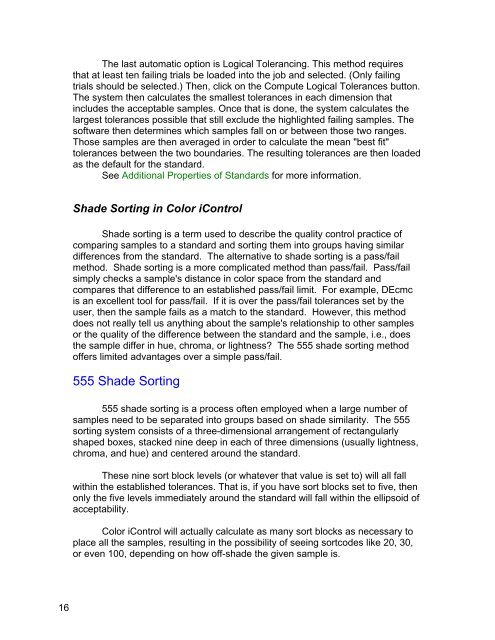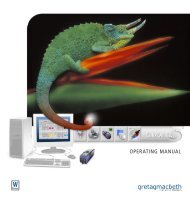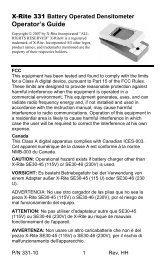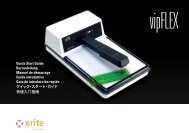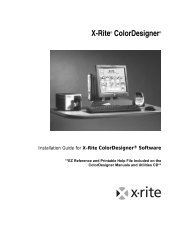Color iQC Help - X-Rite
Color iQC Help - X-Rite
Color iQC Help - X-Rite
You also want an ePaper? Increase the reach of your titles
YUMPU automatically turns print PDFs into web optimized ePapers that Google loves.
The last automatic option is Logical Tolerancing. This method requires<br />
that at least ten failing trials be loaded into the job and selected. (Only failing<br />
trials should be selected.) Then, click on the Compute Logical Tolerances button.<br />
The system then calculates the smallest tolerances in each dimension that<br />
includes the acceptable samples. Once that is done, the system calculates the<br />
largest tolerances possible that still exclude the highlighted failing samples. The<br />
software then determines which samples fall on or between those two ranges.<br />
Those samples are then averaged in order to calculate the mean "best fit"<br />
tolerances between the two boundaries. The resulting tolerances are then loaded<br />
as the default for the standard.<br />
See Additional Properties of Standards for more information.<br />
Shade Sorting in <strong>Color</strong> iControl<br />
Shade sorting is a term used to describe the quality control practice of<br />
comparing samples to a standard and sorting them into groups having similar<br />
differences from the standard. The alternative to shade sorting is a pass/fail<br />
method. Shade sorting is a more complicated method than pass/fail. Pass/fail<br />
simply checks a sample's distance in color space from the standard and<br />
compares that difference to an established pass/fail limit. For example, DEcmc<br />
is an excellent tool for pass/fail. If it is over the pass/fail tolerances set by the<br />
user, then the sample fails as a match to the standard. However, this method<br />
does not really tell us anything about the sample's relationship to other samples<br />
or the quality of the difference between the standard and the sample, i.e., does<br />
the sample differ in hue, chroma, or lightness? The 555 shade sorting method<br />
offers limited advantages over a simple pass/fail.<br />
555 Shade Sorting<br />
555 shade sorting is a process often employed when a large number of<br />
samples need to be separated into groups based on shade similarity. The 555<br />
sorting system consists of a three-dimensional arrangement of rectangularly<br />
shaped boxes, stacked nine deep in each of three dimensions (usually lightness,<br />
chroma, and hue) and centered around the standard.<br />
These nine sort block levels (or whatever that value is set to) will all fall<br />
within the established tolerances. That is, if you have sort blocks set to five, then<br />
only the five levels immediately around the standard will fall within the ellipsoid of<br />
acceptability.<br />
<strong>Color</strong> iControl will actually calculate as many sort blocks as necessary to<br />
place all the samples, resulting in the possibility of seeing sortcodes like 20, 30,<br />
or even 100, depending on how off-shade the given sample is.<br />
16


